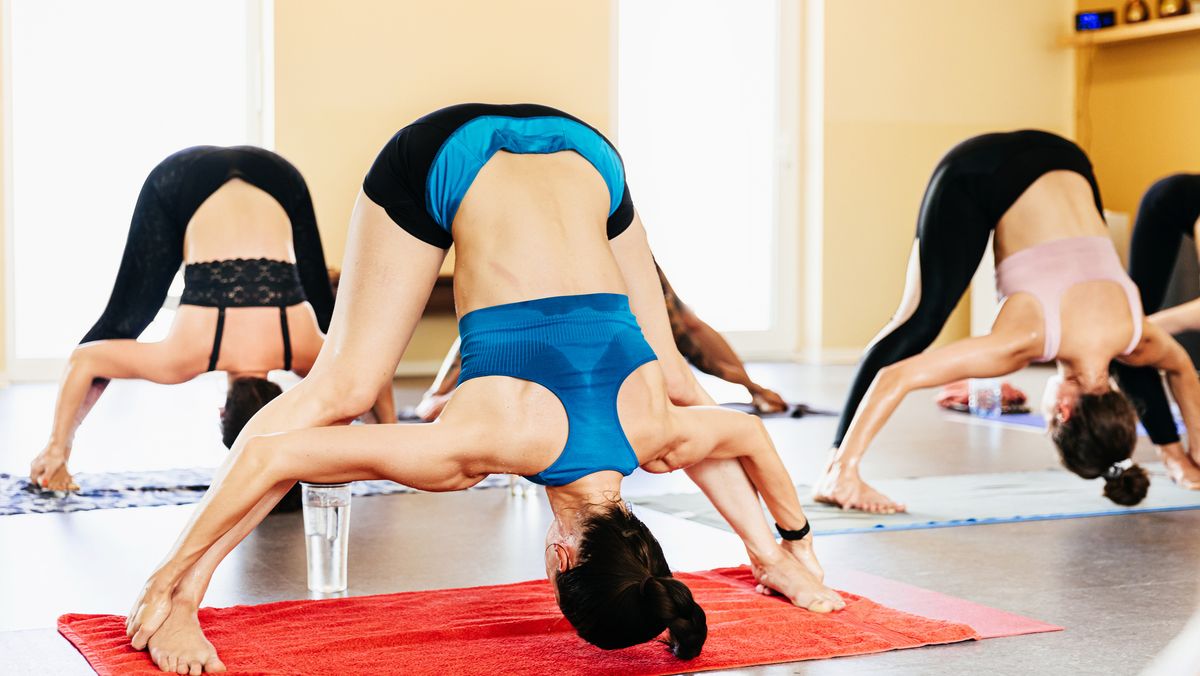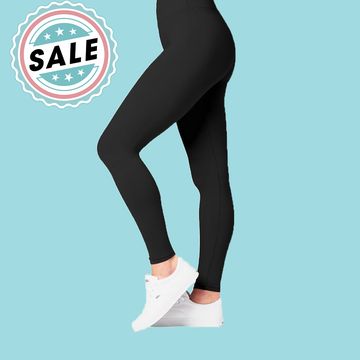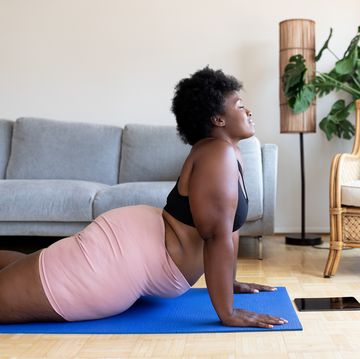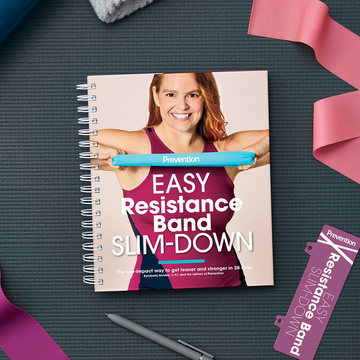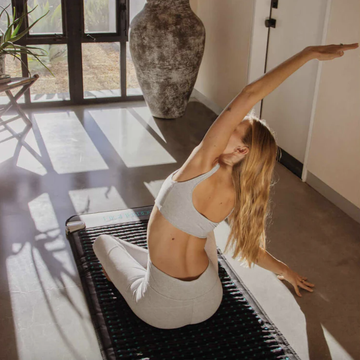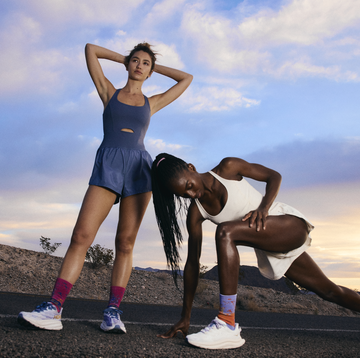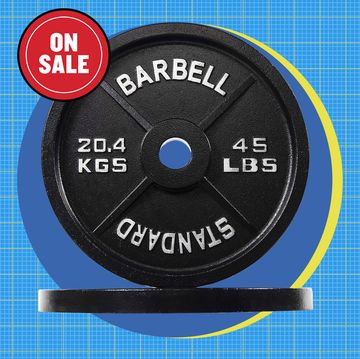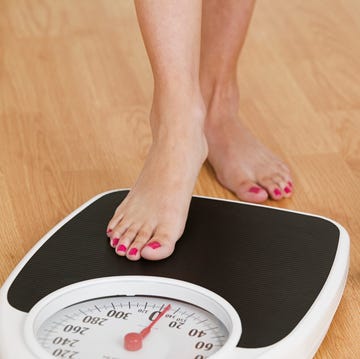The benefits of yoga practice are well-known, from helping with arthritis pain, to increasing mobility, to relieving stress, to even aiding in weight loss goals. There are many different types of yoga that help with their own variety of health concerns. So, what about the benefits of hot yoga?
Hot yoga, sometimes referred to as Bikram yoga, can seem intimidating to a yogi novice, especially those of us that are still mastering our sun salutations. Still, when you crank up the heat in your daily flow, you may be able to reap even more health benefits too.
Meet the Experts: Maria Andrews, registered yoga teacher and editor at Yogajala; Kenta Seki, celebrity health and fitness coach and certified yoga instructor; Nicole Wood, RYT-500 and master trainer for YogaSix.
So, before you grab your yoga mat and bag and head to your next class, here’s everything our yoga experts think you should know about hot yoga, what benefits you can expect, and how to be safe during your practice.
What is hot yoga?
Hot yoga can embody any type of yoga which is practiced in a heated environment, and the ranges of temperature and humidity can vary depending on the style you are practicing, says Maria Andrews, registered yoga teacher and editor at Yogajala. “However, hot yoga rooms are generally heated anywhere from 80-108 degrees Fahrenheit. Hot yoga is designed to make you SWEAT!” she notes.
Hot yoga first became popular in the 1970s, when the manufactured hot environment began to mimic the reality of practicing yoga where it originated in its hot and humid beginnings, India. The founder, Indian-American yoga guru Bikram Choudhury, started utilizing heated studios, and then hot yoga studios started popping up all over the world. However, despite many people assuming that hot yoga and Bikram yoga are one in the same, Bikram is one particular branded style of hot yoga, but not all hot yoga would be considered a Bikram class.
There are various styles of yoga that one can do in a heated room, says Nicole Wood, RYT-500 and master trainer for YogaSix. “The style of yoga could be vigorous (such as vinyasa), or more mellow (such as restorative),” she explains. The yoga that one performs in a heated room can be the same yoga that is performed in a non-heated room. “Again, it all ties back to the school of yoga and its philosophies,” Wood adds.
Hot yoga benefits
In general, yoga can help improve strength, flexibility, balance and focus, says Kenta Seki, celebrity health and fitness coach and certified yoga instructor. Still, when you kick the heat up a notch, here are even more benefits to explore:
1. Increases your flexibility
Hot yoga can also reduce the risk of injuries as opposed to regular yoga practice, says Andrews. “This is because it elevates the core body temperature, warming your muscles and increasing blood flow, which increases flexibility and reduces muscle stiffness.” This also results in an increased range of motion, allowing you to stretch deeper into poses than yoga practiced in cooler environments, she adds.
Hot yoga increases your body temperature faster than most types of non-heated yoga, agrees Seki. “This can allow your body to loosen up and potentially increase flexibility faster than in a non-heated room,” he explains.
2. Decreases stress
Hot yoga can also help decrease stress and potentially improve mental health, says Seki. While yoga at cooler temps can also be effective at stress relief, turning up the heat can give you an extra boost of relaxation.
One study that followed stressed, physically inactive adults found that a 16-week program of hot yoga significantly reduced the participants’ stress levels. Researchers also found that hot yoga improved their health-related quality of life, as well as their self-efficacy—the belief that you have control over your behavior and social environment.
3. Helps treat depression
In one 2023 study of adults with moderate-to-severe depression, those who participated in heated yoga sessions experienced significantly greater reductions in depressive symptoms compared with a control group. Moreover, the adults in the clinical trial experienced a 50% reduction in depressive symptoms, and 44% of participants were considered in remission by the end of the study.
4. Helps you sweat more
There are many benefits of hot yoga and associated with sweating itself, says Andrews. For example, certain toxins in the body (any substance that irritates, damages, or impairs the activity of the body’s tissues) may be eliminated through sweat. “Eliminating these in the body may balance hormones and aid metabolism,” she adds.
More sweat can also help increase circulation to your skin, says Seki. This, in turn, may help to nourish your skin from the inside out.
5. Boosts your immune system
The increased blood flow through the body when practicing hot yoga may also strengthen your immune system, says Andrews. “Holding yoga poses causes your muscles to propel the circulation of lymph (which circulates immune cells throughout the body), and in the same way, blood circulation increases, as does lymphatic circulation,” she explains.
6. Improves heart health
Heat can increase your heart rate, which can potentially improve your cardiovascular health, says Seki. In fact, one study found that just one session of hot yoga is enough to get your heart pumping at the same rate as a brisk walk (3.5 miles per hour).
Studies have also found that hot yoga can lower your blood pressure more effectively than normal yoga flow. The hot yoga-goers’ systolic blood pressure dropped from an average of 126 at the study’s start to 121 after 12 weeks. Also, their average diastolic pressure decreased from 82 to 79.
7. Reduces blood glucose levels
While any type of cardio can help burn energy and reduce circulating levels of glucose (sugar) in your bloodstream, hot yoga may be especially helpful for people at higher risk for type 2 diabetes. One study found that a short-term Bikram yoga program significantly improved glucose tolerance in older adults with obesity.
8. Builds bone density
Building bone density is especially important for older adults and premenopausal women, as bone density declines as you age. And while supporting your weight during a yoga pose can help, hot yoga can help that much more for your bone health.
One study of women who participated in Bikram yoga over a 5-year period found that premenopausal women had increased bone density in their neck, hips, and lower back. The authors of the study concluded that Bikram yoga may be an effective option for reducing the risk of osteoporosis in women.
9. Burns more calories
If you have weight loss goals, hot yoga could work to your advantage. Heat can increase your heart rate, which can potentially increase your calorie burn during class, says Seki. One study found women burned an average of 333 calories during a 90-minute slow-moving, heated yoga session.
What to know before trying hot yoga
Hot yoga is challenging, but it can feel really good, says Andrews. “By exercising in a warmer environment, hot yoga challenges your body, mind, and spirit. It causes you to sweat, requires you to focus and challenges your ability to find stillness more than other yoga styles,” she explains. However, after all that, you’ll be sure to leave a hot yoga class feeling healthy, energized and proud you endured the session, she adds.
Note: If you are hoping for weight loss from your hot yoga exercise, Andrews says to set your expectations appropriately. “Whilst yoga is not the most effective form of exercise for burning calories because it is not particularly intense, hot yoga can be more intense on the body in this sense than gentler practices,” she says. However, most initial weight loss from hot yoga can be attributed to water loss through sweating, and “it is very important for anyone practicing hot yoga to rehydrate as soon as possible after workouts,” she notes.
Hot yoga safety
While hot yoga boasts many benefits, there are risks associated with practicing exercise in a hot, humid room, says Andrews. Therefore, there are some safety tips anyone practicing should know and some people who should avoid the practice altogether.
The biggest concern when it comes to hot yoga practice is dehydration. Sweating can result in significant fluid loss, which can increase the risk of dehydration, says Andrews. “In the heat, the onset of dehydration can sneak up on you quickly and perhaps leave you feeling dizzy or nauseous. But this risk is easy to minimize by drinking plenty of water before, during and after your session—ensuring you rehydrate fully,” she advises.
It’s not uncommon to feel lightheaded in a hot yoga class, says Wood. “If this occurs, lower your body towards the floor where it is cooler. Take a seat or choose a posture like child’s pose to help regulate your system. Know that you can always step out of the room to cool off,” she advises.
While hot yoga can increase your flexibility and reduce muscle stiffness, it can also be pretty easy to over-stretch and hurt yourself in these classes due to that increased range of motion. “People who are new to the practice should ease into it slowly so as not to risk overexerting their bodies but instead, steadily build their stamina,” says Andrews. So, if you’re a first-timer, proceed with caution when finding deeper stretches and don’t push yourself past your limits.
Yoga is not an inherently dangerous activity, says Wood. “My best advice when it comes to safety is to listen to your body. Back out of a pose if something doesn’t feel right. Take a break or grab a sip of water when you need to rest or if you are feeling overheated,” she suggests.
Who should avoid hot yoga?
Those who have some pre-existing medical conditions such as migraines, respiratory conditions like asthma, cardiovascular conditions such as heart disease or high or low blood pressure, or are on certain prescribed medications should avoid any hot yoga practice without first speaking to a medical professional, says Andrews. “Healthcare professionals can offer personalized advice and recommend specific precautions to ensure safe practice for the individual,” she says.
Pregnant individuals are generally advised to avoid activities that can lead to overheating and potential harm to the fetus, adds Andrews. “Therefore, it is recommended that pregnant women consult a qualified prenatal yoga instructor for safe pregnancy-specific yoga practices and avoid hot yoga,” she explains.
Additionally, if you have any injuries that might affect your practice, always check with a professional before coming to make sure you are cleared, and be sure to let your yoga instructor know of your injuries before class, says Seki.
How to get started
Working out in high heat is significantly different and can be far more challenging than standard indoor exercise—even the fittest shouldn’t underestimate hot yoga if they’re a complete beginner, says Andrews. “Beginners should ease gradually into hot yoga by taking shorter sessions at first and breaks whenever they feel necessary,” she notes.
If you’re new to yoga, Seki recommends going to a few non-heated yoga classes first so that you become comfortable with the basics before you practice in the heat. Some hot yoga studios also offer beginner classes where the room is less hot and the practice is slower and less challenging, he says.
It takes time to acclimate to the heat, so be patient and take each class at your own pace, says Seki. “Pay attention to how your body feels throughout class. If you start to feel lightheaded or dizzy, it’s totally okay to rest in a seated or grounded pose like child’s pose or savasana until you feel better.” If you still don’t feel well after a few minutes, leave the room and cool off.
Remember, if you get dizzy, it doesn’t necessarily mean hot yoga isn’t for you, says Seki. “If done safely and gradually, most bodies adapt to the heat with time.”
Most importantly, make sure you hydrate before, during, and after class.
What to bring to hot yoga
You should bring all the ordinary yoga essentials to a hot yoga class, including a non-slip yoga mat, plenty of water, and a yoga towel, says Andrews. “However, it is recommended that you bring an extra towel, too, to dry off after the class so you can leave feeling your best,” she adds. If you do not have these items, call the studio and ask if they have them for use, for rent, or for purchase, suggests Wood.
As for attire, choose breathable, athletic clothing that is comfortable and easy to move in, says Wood. Remember that comfort is key, and that starts with the undies, says Andrews. “Ensure they are comfortable and non-restrictive, so you do not have to keep readjusting, along with a moisture-wicking sports bra.”
You also might want to bring a change of clothes for after class, suggests Seki. “And if you have long hair, bring a headband, bandana or other type of hair tie that can help keep your hair out of your face.” Make sure to also shower as soon as possible after class, says Seki. “Sweat can be great for your skin, but if you leave it for too long, bacteria can grow and lead to acne and other skin issues,” he explains.
And before you head into the studio, be sure to fuel your body before taking class, says Wood. “Drink water and eat a small healthy snack before and after you practice. Utilize electrolytes as well to aid in your recovery,” she suggests. Staying hydrated and eating enough food is essential to ensuring that you are safe to enjoy your hot yoga practice.
Madeleine, Prevention’s assistant editor, has a history with health writing from her experience as an editorial assistant at WebMD, and from her personal research at university. She graduated from the University of Michigan with a degree in biopsychology, cognition, and neuroscience—and she helps strategize for success across Prevention’s social media platforms.
